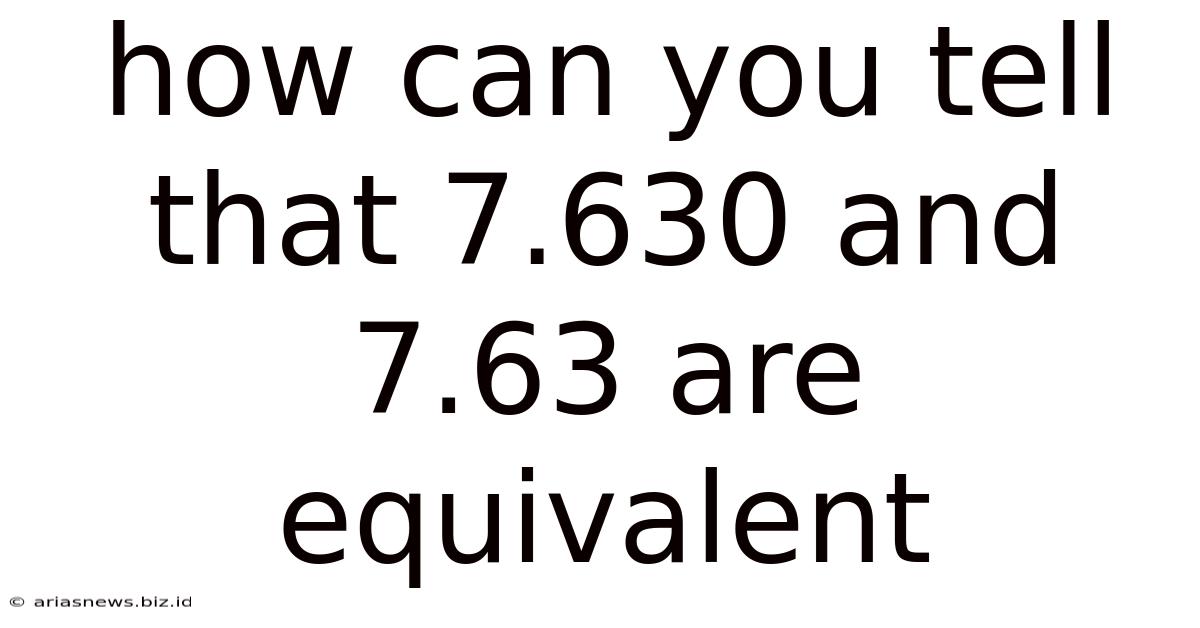How Can You Tell That 7.630 And 7.63 Are Equivalent
Arias News
May 10, 2025 · 4 min read

Table of Contents
How Can You Tell That 7.630 and 7.63 Are Equivalent?
Understanding the equivalence of numbers, especially decimals, is fundamental to mathematics and its applications. At first glance, 7.630 and 7.63 might appear different, but a deeper understanding of decimal place value reveals their underlying equality. This article will explore the concept of decimal equivalence, explain why 7.630 and 7.63 are the same, and provide various methods to demonstrate this equivalence. We'll also delve into practical applications and potential misconceptions to ensure a comprehensive understanding.
Understanding Decimal Place Value
The cornerstone of comprehending decimal equivalence lies in understanding place value. Every digit in a decimal number holds a specific position, representing a multiple of powers of 10. Let's break down the place values:
- Ones: The digit to the left of the decimal point represents the number of ones.
- Tenths: The first digit to the right of the decimal point represents the number of tenths (1/10).
- Hundredths: The second digit to the right of the decimal point represents the number of hundredths (1/100).
- Thousandths: The third digit to the right of the decimal point represents the number of thousandths (1/1000).
- And so on...
In 7.630, we have:
- 7 ones
- 6 tenths
- 3 hundredths
- 0 thousandths
In 7.63, we have:
- 7 ones
- 6 tenths
- 3 hundredths
The Significance of Trailing Zeros
The key difference between 7.630 and 7.63 lies in the trailing zero after the 3 in 7.630. A trailing zero in a decimal number after the last non-zero digit does not change the value of the number. It simply adds a further level of precision, indicating that the measurement or value is precise to the thousandths place. However, it does not add any additional value to the number itself.
Think of it like this: if you have 7.63 dollars, it's the same as having 7.630 dollars. The extra zero in the thousandths place doesn't add any extra money; it only implies a higher level of accuracy in the measurement. You could have measured the amount to the nearest thousandth of a dollar, but the value remains unchanged.
Mathematical Proof of Equivalence
We can mathematically prove the equivalence using fractions. Let's convert both decimals into fractions:
- 7.630: This can be written as 7 + 6/10 + 3/100 + 0/1000 = 7630/1000
- 7.63: This can be written as 7 + 6/10 + 3/100 = 763/100
Now, let's simplify the fractions:
- 7630/1000 can be simplified by dividing both numerator and denominator by 10: 763/100
- We see that both fractions are now identical: 763/100
Since both decimals simplify to the same fraction, they are equivalent.
Visual Representation
Imagine a number line. Both 7.630 and 7.63 would occupy the exact same point on that number line. This visual representation reinforces the idea that they represent the same numerical value.
Practical Applications
The understanding of trailing zeros and decimal equivalence is crucial in various fields:
- Finance: In financial calculations, knowing that 7.630 and 7.63 are equivalent is essential for accurate accounting and financial reporting.
- Science: In scientific measurements, understanding the significance of trailing zeros helps interpret the level of precision in the data. For example, a measurement of 7.630 cm implies higher precision than a measurement of 7.63 cm.
- Engineering: Precision is paramount in engineering, and understanding decimal equivalence ensures that calculations and designs are accurate.
- Programming: In computer programming, representing numbers with trailing zeros might be necessary for certain data types or to maintain consistency in calculations.
Common Misconceptions
One common misconception is that adding a trailing zero increases the value of a decimal number. This is incorrect. The trailing zero only signifies increased precision in measurement or representation, not a change in the actual numerical value.
Another misconception is the assumption that all trailing zeros are significant. This is also incorrect. Only trailing zeros after the last non-zero digit are insignificant and don't affect the value.
Expanding the Concept
The principle of trailing zeros and equivalence extends beyond the example of 7.630 and 7.63. Any decimal number with trailing zeros after the last non-zero digit is equivalent to the same number without those trailing zeros. For example:
- 12.500 = 12.5
- 0.0400 = 0.04
- 250.0 = 250
Conclusion
The equivalence of 7.630 and 7.63 is a fundamental concept in mathematics. By understanding decimal place value, the significance of trailing zeros, and the mathematical proofs, we can confidently assert their equality. This understanding is crucial for accuracy and consistency across various fields requiring numerical precision. While seemingly simple, the concept of decimal equivalence underpins many complex calculations and applications, emphasizing the importance of a robust understanding of basic mathematical principles. Remember, context matters. While the numerical value is the same, the number of significant figures implied by 7.630 versus 7.63 might differ significantly, particularly in scientific or engineering contexts. The trailing zero indicates a greater level of precision in measurement, even if the numerical value is identical.
Latest Posts
Latest Posts
-
60 Miles Per Hour Into Meters Per Second
May 10, 2025
-
How Many Amps Does A 12000 Btu Ac Use
May 10, 2025
-
Can You Rinse Your Hair After A Perm
May 10, 2025
-
What Percentage Is 1 Million Of 1 Billion
May 10, 2025
-
5 Letter Word With Second Letter I
May 10, 2025
Related Post
Thank you for visiting our website which covers about How Can You Tell That 7.630 And 7.63 Are Equivalent . We hope the information provided has been useful to you. Feel free to contact us if you have any questions or need further assistance. See you next time and don't miss to bookmark.